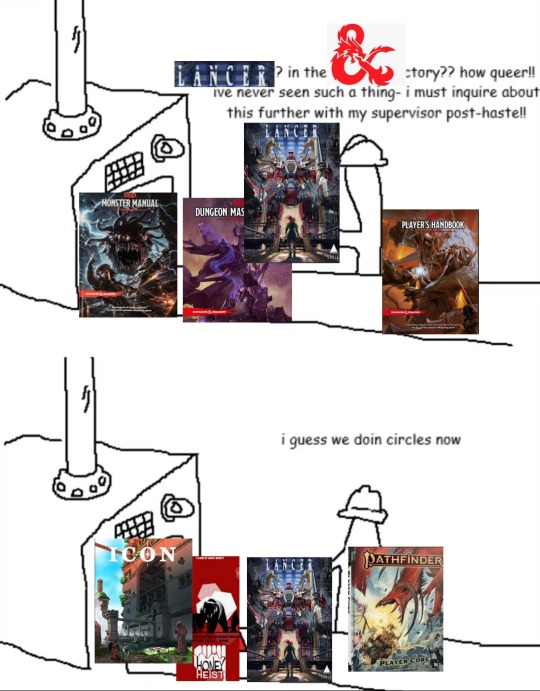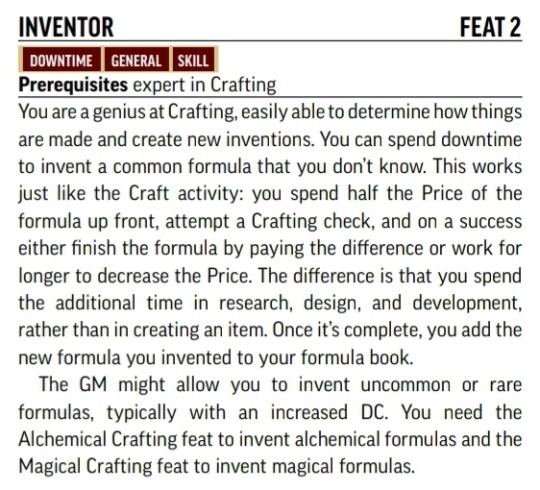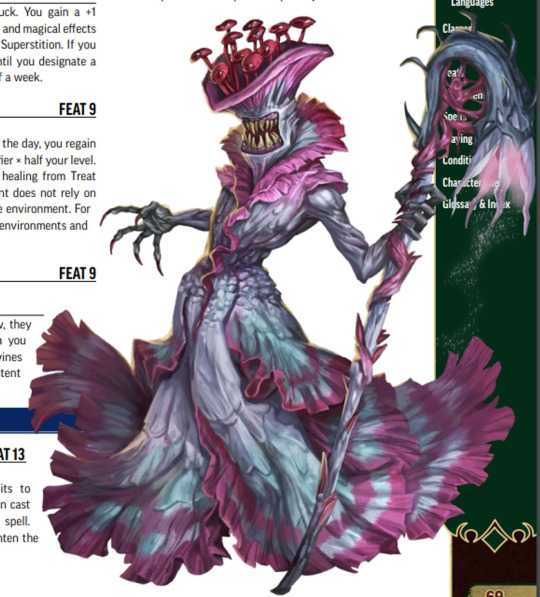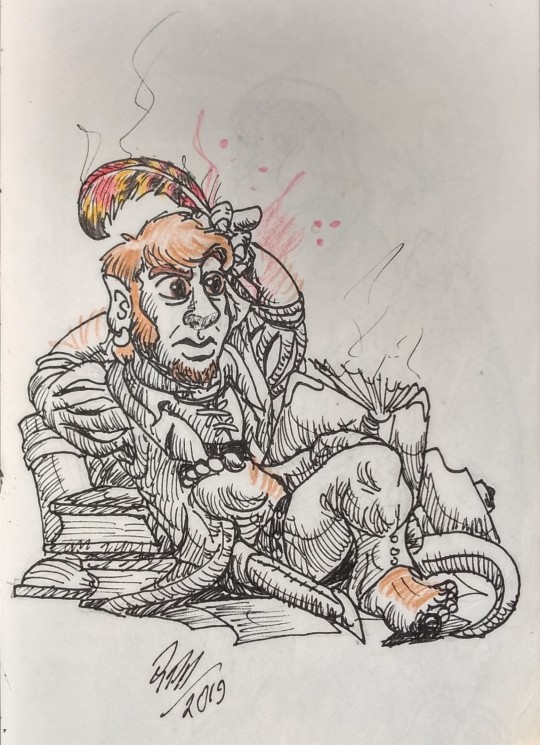#Pathfinder Remaster
Explore tagged Tumblr posts
Text

#ttrpg#indie ttrpgs#trpg#indie trpg#tabletop roleplaying#tabletop rpg#tabletop#tabletop gaming#dnd#d&d#d&d 5e#dungeons and dragons#dungeons & dragons#lancer#lancer rpg#icon#icon rpg#massif press#tom parkinson-morgan#pathfinder#pathfinder rpg#pathfinder remaster#pathfinder 2e#pf2e#pf2#honey heist#grant howitt#triangle factory#i guess we doin circles now
254 notes
·
View notes
Text
One thing I really like in the remastered Pathfinder Core books, that I haven’t seen anyone else talk about yet, is these little flavor descriptors in each caster class’s Spellcasting feature:
As a wizard, when you cast spells, your incantations likely specify exactly what forces you call on and how to shape them, and your gestures precisely shape and direct your magic while circles of arcane runes flare to life.
Look at that! Pre remaster that was just “you use material components from a pouch”. Now there’s specific role play guidance like “Throw some mustard on that spell. Go all ‘BY THE EIGHT WINDS AND THE TWELVE STARS’ on some guys.”
And there’s one for every class!
As a bard, when you cast spells, your incantations might be musical riffs or clever limericks, your gestures might incorporate dance and dramatic pantomiming, and you might accompany your spellcasting by playing a musical instrument.
As a cleric, your chants generally invoke your deity and their powerful servants by name or title, while your gestures are followed by sacred symbols or other representations of your deity
As a druid, your spellcasting incantations might be pleas to the environment around you or the invocation of ancient vows; your hands might sway like willows or curl into clawlike shapes as your gestures direct your magic.
As a witch, when you cast spells, your incantations might rhyme, your gestures might be as simple as an ominous pointing finger or a complex folk sign, and your familiar might even echo your words or movements slightly as your patron's magic surges.
Just a little nudge toward roleplay potential in a central aspect of the game and how it differs from class to class, character to character.
They even brought it back for Player Core 2! “A Sorcerer with a demonic bloodline might chant guttural fiendish phrases or make brief curt gestures to cast a spell.” “As an Oracle, when you cast spells, your incantations may spill from your lips rapidly as you speak in tongues or intone in a voice not quite your own…”
Great stuff all around.
#pathfinder#pathfinder 2e#pathfinder 2nd edition#pathfinder remaster#player core 2#pathfinder player core 2#magic#spellcasting#ttrpg#tabletop rpgs#tabletop roleplaying#paizo
22 notes
·
View notes
Text
A Short Review of the PF2e Remaster Crafting Rules

Crafting! Every Intelligence spellcaster's (and Alchemist, Munitions Crafter Gunslinger, Inventor, and Alchemical Sciences Investigator) favorite skill. In Pathfinder 2e pre-remaster, the Crafting skill and its Craft activity were generally... underused. The Craft activity asked of you 4 days to produce one permanent item or 4 consumables at full price after you also bought the formula for it, and most adventure paths just didn't have the downtime to allow for it to be useful with the real benefit of spending extra time to reduce the price of the items down by your Earn Income amount for your Crafting skill. However, with Player Core 1, that's changed! So, first, let's go over what changed from the CRB.
I Can Make a Spoon in 1 Day Now: The Changes to Crafting
The following are some of the most notable changes to Crafting and the Craft activity:
CRB: Crafting items takes 4 days of downtime, and you must have the formula. You must provide half the materials upfront and pay the rest of the value after the 4 days are finished, but you can spend can spend extra days to reduce the price further, up to half the total value of the item.
PC1: Crafting items takes 1 - 2 days of downtime. 1 day if you have the formula, 2 days if you don't have the formula. Any common item can be crafted without a formula. You must provide half the materials upfront and pay the rest of the value after the 4 days are finished, but you can spend can spend extra days to reduce the price further, up to half the total value of the item.
The following feat was altered with these changes to the rules:

Inventor was moved down from a 7th level skill feat that required Master in Crafting to a 2nd level skill feat that requires Expert in Crafting. Additionally, it now says the GM can allow you to use the Craft activity to make uncommon and rare formulas, which you do need if you want to craft those items.
Spoons are Nice, But How About This Healing Potion: How Crafting Helps Every Party Now
So, with those changes, there is a notable difference with Crafting now: you only need 1 day to make stuff (if you have the formula). 1 day of downtime is stupid easy to come by in a majority of APs and homebrew games, heck 2 isn't a big ask either. The biggest benefit this provides is the savings, however. By reducing the downtime required from 4 days to 1, that gives you 3 days you typically would've spent making a wicked new magic longsword for Seelah as extra days you can spend to get savings you wouldn't have been able to get otherwise. This makes feats like Impeccable Crafter have much more value, since you can take advantage of getting a critical success on your Crafting check a lot more now.
But, let me provide a recent experience. In my current campaign, my GM gave the party a month of downtime before PC1 came out while I ran Malevolence for everyone to give him a break. I wanted to craft the following:
4x Cheetah's Elixirs (Moderate)
4x Elixirs of Life (Lesser)
1x Eye Slash (Greater)
4x Oils of Mending
4x Predator's Claws (Formerly called Owlbear Claws)
My Gunslinger/Inventor has the following skill feats and items to help with Crafting, with her Master Crafting proficiency:
Crafter's Eyepiece
Speciality Crafting (Alchemy)
Tattoo Artist
Overall, I got 4 critical successes, 1 success, and 1 critical failure on my die rolls. In total, I spent 25 days performing the Craft activity to make of all of this, spending lots of extra days to reduce the total cost of the items be crafted by half. In total, I spent 6 days making the items, and 19 days finishing them for the discount.
With the CRB rules, I would've spent a total of 24 days making the items, and then 19 days finishing them for the discount, for a total of 43 days spent Crafting, 13 days over my limit of 1 month.
Simply put, if I used the CRB Crafting rules, I would've had to spend much more gold, but I also likely wouldn't had taken the time to make the Oil of Mending for our Inventor, or the Eye Slash for our Barbarian. The new Crafting rules provide incentive for players to not only make cheaper items, thus spend less gold, but also make more items too since you're spending way less time.
We Only Have 1 Apex Item Between Us All: How the Formula Changes Helps High-Level PF2e

A minor issue high-level PF2e APs have is item droughts. Acquiring the equipment you need can be difficult because it doesn't drop, and unless you have access to a city like Absalom with a high settlement level, it won't be sold either. The issue can mainly be seen in acquiring Apex Items, some of the best magical gear available to high-level PCs that boosts 1 ability score to +4, or increases it by +1 if it's above that already. This is essential for getting a +7 in your primary ability score. The main problem, however, is that most APs (barring a few like Stolen Fate) don't drop apex items for every stat and buying them could be out of the question either due to not having enough gold or just no place to purchase. The solution to this was supposed to be Crafting, but small issue, you needed a formula to craft it, and that was just as hard to get.
However, the recent change makes it so that common items require no formula at all, you just need to spend 2 days on the Craft activity instead! And what are apex items and their rarity at typically? Common. With this, plus the lowered downtime required to finish the initial item, if a party has a crafter, getting cheaper apex items can be simple provided you find time for a little bit of downtime from levels 17 - 20 (which can still be a big ask, but not as big as before). This means, that perhaps everyone can get access to the prestigious magic items and enjoy the benefits of the power they entail.
In Conclusion
The PC1 Crafting changes have been a boon to everyone interested in the skill, and everyone who loves playing with them too. The reduced amount of downtime required leads to cheaper items, and/or more items. While the formula changes provide more versatility in what one can craft for their party and themselves.
77 notes
·
View notes
Text

Paizo really just went "Fuck it" and made non-binary plant people a core player ancestry in the 2e remaster.

Non-binary icon
65 notes
·
View notes
Text
Okay, so Archives of Nethys has updated to have some material from PF2e’s Remaster. And I like the new Wizard Arcane Schools? They’re actually really exciting to me.
Moving away from D&D’s schools of magic, abjuration, necromancy, etc, spells don’t have a school anymore, though studying an arcane school will let you learn certain spells. But these schools are more … I don’t want to say ‘practical’, but they do kind of feel like … magic you study towards a purpose? It’s not about what the spells are, the arbitrary categories they’re deemed to fit into, it’s about the kind of things you want your magic to do. Your school is a collection of magic you’ve studied towards a goal. I’m not sure how to phrase this, but I like the ethos. And. There’s just a couple of particular schools that excite me just for existing.
Particularly, I’m just going to be honest here, the School of Civic Wizardry. Is it a good subclass? I have no clue. But I love that it’s a thing that exists. If you want to study magic to build things, to transport things, if you want to be an architect arcane, honey baby, have we the school for you! If you became a wizard to help build and maintain cities, there’s now a school for that. That just makes me happy.
I also enjoy the School of Ars Grammatica. It’s the school of runes and wards, the magic of words, the underpinning geometries of magic. Wards are an idea in fantasy that have always fascinated me, and you also can’t go wrong with the magic of communication.
Then there’s the School of the Boundary, for when you want to get spooky. This is the school of summoning, seeing, traversing. Trespass and transgress. I really really really like the boundary, the liminal, as a theme. People may have noticed. So, yes. Excellent school. Do enjoy it.
And then, of course, there’s the School of Mentalism. The magics of the mind. I just really like illusions?
This is not to knock the schools of Battle Magic, Protean Form or Unified Magical Theory, of course. I’m just. Likely gonna pick a few of the others first.
I do also love that the entries for each give examples of actual schools, as in places in the setting, where you might have learned particular Arcane Schools. Embedding your mechanics in your setting, and vice versa, is always a thing I enjoy.
But yes. I really just want a wizard construction worker now? An architect arcane. None of this arty farty ‘what is the meaning of magic’ stuff, magic is so you can build a building without having to move rocks with your body like an idiot. Okay? Magic exists so we can make things easier. There’s no need to get complicated and silly about it.
It’d be funny to have a party that’s a small wizard construction/building inspection firm? You have your Civic Wizard who does the building, your Ars Grammatica Wizard who does the warding and puts the magical phones in, and then you have the black sheep, the Boundary Wizard, who does building inspections and tells people whether their shit’s haunted or if they just built too close to the sewer and the ventilation in this end of the city isn’t the best.
I’m intrigued, let’s say. I like where this is going. And yes, I’m gonna make a dwarven wizard in a hard hat and sturdy boots. Naturally. Heh.
#pathfinder#pf2e#pathfinder remaster#wizards#schools of magic#construction wizards#i just love it#a lot
30 notes
·
View notes
Text

Been reading the new player core 2 for Pathfinder 2e and apparently HRT has different power tiers?!?! Like you can fully transition in half a year but you'll need 6 alchemist levels sorryyy
13 notes
·
View notes
Text
Let's Try Dawnsbury Days |01| THE FIRST PATHFINDER 2E CRPG
Look to the indie badasses to make the first Pathfinder 2e game accurate to the system itself! Behold character creation to the cheap, beginner friendly Dwansbury Days!
#dawnsburydays #pf2e #crpg
youtube
#Dawnsbury Days#PC#Topdown#TTRPG#Tabletop RPG#Roleplaying Game#turn-based#CRPG#OGL#Pathfinder#PF2e#Pathfinder Remaster#Strategy#indie Game#Dawnsbury Studios#voice acting#Youtube
8 notes
·
View notes
Text
Horned Dragon (Paths Beyond)
My patrons expressed interest in a few of the remastered monsters that got a facelift, and I am thrilled to present the first one: the horned dragon. With the remaster project, Paizo had to chuck the classic chromatic and metallic dragons out with the bathwater. Or at least they had to check their names out. While Monster Core is full of brand, new and deliciously weird dragons, there is a familiar face. The green dragon has been redubbed in favour of its horn, making it clear all the dragons we love to love and love to hate are still around. Expect the other metallics and chromatics to reappear with a fresh coat of paint as time goes on. In the meanwhile, horned dragons have literal decades of lore we can draw upon.

Art by Ben Wootten
The most notable change to horned dragons in the Remaster is trading the arcane spellcasting tradition for primal. This aligns with their fondness for woodlands and linguistic talents for both elven and fey, although their erudite minds still resonate with the arcane tradition. There is an overlap between the two in shapechanging and elemental magics, which suggests some themes to worm horned dragons around. And, as I will frequently say when dealing with the Remaster, there's no reason you can't just go with the classic arcane caster and all that entails, especially if that's what makes sense for the story.
Horned dragons have a reputation for being intellectuals, but they do have a gap in their knowledge: the outer sphere. For those of us who harken back to the Planescape days or focus our planar games on the afterlife, that sounds like a significant gap. Likewise, they know relatively little about outsiders, and the undead. It is worth remembering, however, that this is the only gap in their knowledge when it comes to planar affairs. Horned dragons are trained in Arcana, Nature, and Occultism, with even a young dragon able to beat expert level DCs reliably. Add in the fact they’re experts in society as well, and they know about almost every type of monster that’s out there too. Horned dragons don’t just have a reputation for being smart, they are genuinely brilliant and unlikely to let you forget it. What that means is that horned dragons could be the masterminds behind any plot involved in the planes. Or they could be the ones who dispense a crucial piece of information to the party. Or both. Probably both.
Deep within the Hanging Bower is one of the Green Mother's favourite concubines: the horned dragon Urðvox, the Hungering Mind. Her title was bestowed by her Eldest mistress, for Urðvox role the Green Mother's court is to speak for and embody mental seduction. Hours of conversation with the ancient worm pass in the blink of an eye, but the horned dragon only hints at her great knowledge. Those who wish to learn her secrets must tease apart the few crumbs the dragon give, all while being careful not to get drawn in too quickly.
The oddest monastery exists in the Napsune Mountains, founded by Zestrex, a young but capable horned dragon. The dragon is enamoured with the Laws of Mortality, scoffing at the prospect divinity makes one more worthy than intellect. Upon arriving in Rahadoum, Zestrex found many restless spirits, mortal and elemental alike, and resolved to gather them to himself. Now, Zestrex studies the primal and occult forces at work within his disciples while helping them move on or return to their planes of origin.
Imetx lives a contemplative live of seclusion and reflect on the Ethereal Plane. She considers herself a gardener, but unlike horticulturalists on the Universal Plane, what she cultivated are emotions. Anger blossoms, red and stinging, on fleshy vines that must be constantly trimmed. Joy is a field of yellow blooms, as far as the eye can see. The white stalks of fear are rarely seen, for it is never Imetx’s own fear, but that of those who see her imposing form. An authority on the In-Between’s emotional resonance, Imetx can provide information or ritual components relating to aura reading.
While horned dragons are known for pursuing self-perfection, they can be protective of other beings they view as perfect, to the point of possessiveness. Giorgis the Pure sees unicorns in this way — they represent perfect virtues, are perfect horses, and serve as perfect emissaries between the mortal world and the First World. The horned dragon obsessively tracks in the comings and goings of all unicorns within the forest where he lairs, as well the portals they use to commune with the fey. He has a violent and deep hatred of alchemists, blaming them for alicorn poachers, whether or not they deal in such substances.
Note: If you want to get a vote in the what monsters I cover out of order next, come follow the link at the top (and right here)
I do have some Monster Core writeups done (you can also find them at the link), but I'm waiting for Archive of Nethys to update so I can include art.
18 notes
·
View notes
Text

Ooh, goblin and goblin dog info in the remastered PF2e monster manual! Let's take a look!

EXCUSE ME?!
Goblins HAVE a word for goblin dog. It sounds like the most common sound (sort of a grunt-squeak) a goblin dog makes! Just because the monster manual writers are too racist to learn goblin doesn't mean goblins don't have a word for something.
(Since I've been playing Chaglu I've developed Strong Opinions about Goblin, which is a beautiful and most importantly beautifully-straightforward language, with a lot of compound nouns and a high degree of onomotopeia)
((Because I decided it does, that's why))
#goblins#pf2e#pathfinder remaster#common as a second language#pathfinder#its okay paizo i forgive you#It's your universe#and you're WRONG#tabletop roleplaying
12 notes
·
View notes
Text
I've focused mostly on the remastered classes.
6 notes
·
View notes
Text
Funniest thing in the Monster Core is the suggestion of centuries of intense fueds in the Dragon Taxinomy subreddit
4 notes
·
View notes
Text
I like to imagine the in-world reason for Pathfinder ditching spell-schools is that everybody held on to this ancient Thassilonian system, and then the actual Thassilon starts showing up again, and we see how different they are from the mythology and go ��oh, this whole taxonomy is gobbledygook.
“In retrospect yeah, some wizard despots who lionized their own personality flaws all declared the kind of magic they liked to do an innate classification, and we all just went along with it. Gods’ sake, half these ‘schools’ do 6 unrelated things, but DIVINATION is their waste bin taxon?”
#pathfinder#pathfinder 2e#pathfinder remaster#paizo#paizo publishing#ogl#golarion#thassilon#new thassilon#runelords#schools of magic
37 notes
·
View notes
Text


PATHFINDERS - The Halfling Bard
As I've said many times before, in this same series of drawings, bards are much more than the musicians in an eternal state of lasciviousness and wanting to get laid with everyone, something that they tend to be seen especially by older RPG players. The historical inspiration of the bards includes true human archives, responsible for preserving knowledge, whether of the places where they live or of a specific noble family to which they are linked - William Shakespeare is often called "the English bard" precisely because of this. Furthermore, they do not always need to be linked to musical performances, they can be dancers, actors and, in this case, orators.
I built the idea of this character a little together with my cousin when I made him a Halfling Bard, with a special focus on the oratory aspect and also on the social history of Halflings - in the original idea it was with D&D 3.5e in mind, not Pathfinder 2e, but which ended up fitting here too -, generally shown as a people without a land to call theirs, seen as inferior beings by other societies. Perhaps with this specific bard, using the magical item of a phoenix feather used as a "pen", he will do just that, uniting his people in squares in large urban centers under the banner of an ideology that will free them from oppression - something that is much more obvious in the original drawing, but I hid it here just for better aesthetics.
#artists on tumblr#digital artists#character design#character art#digital drawing#creature design#fantasy#creature art#creature concept#fantasy art#halfling#halfling bard#bard#orator#communist#hobbit#pathfinder remaster#pathfinder#pf2e#ttrpg art#ttrpg#pathfinder character#fantasy character#rpg art#rpg#rpg character
9 notes
·
View notes
Text
differences in quality aside, I think the easiest way to express the difference between One D&D and the Pathfinder 2e Remaster is that One D&D is (despite WotC's protestations) DnD 5.5, whereas the Remaster is Pathfinder 2.1 - the latter truly is, as I believe the designers have said, "Errata Plus," primarily nudging some things into balance, changing names to get away from the OGL, and rewording some confusing/hard to use abilities.
6 notes
·
View notes
Text
Okay. So. Thinking a bit more about that Remastered PF2e Construction Wizard. Some spitballed ideas.
I do want to just fully commit to the construction thing. Is the wizard effective in combat? Possibly not, or not as much as they could be. I want to give them building spells as much as possible. For the skills I think we build around Arcana, Crafting and Society for our three raise-to-legendary ones. This is a city wizard, a construction wizard, their magic is used to make things.
They’re a dwarf. I’m sorry, they’re a wizard who uses the raw forces of magic to build cities, they have to be a fucking dwarf. That’s dwarfy. It just is. Heh. I feel like either an Anvil Dwarf (legacy) to double down on the crafting thing, or a Rock Dwarf, to double down on, well, the rock. The stones and the building. A couple of dwarven ancestry feats that I might want to pick up include Stonemason’s Eye, Dwarven Reinforcement (strengthen objects and structures), Stonewalker (can cast One With Stone, and builds on Stonemason’s Eye), and March the Mines (gain a burrow speed and take an ally along). Dwarves are so good for construction. I told you this was a dwarfy sort of wizard.
For the background, I wanted something with Engineering Lore. Interestingly, a LOT of backgrounds with that lore are tied to either Alkenstar specifically or clockwork/guns/machinery in general, which isn’t quite the vibe I’m going for. And Alkenstar, given the whole ‘unreliable magic’ thing, might possibly be the worst city for this dwarven wizard to be from. In general, backgrounds with engineering lore are all a bit more mechanical than civic engineering.
Somewhat funny, but one of the few Engineering Lore backgrounds that actually specifically mentions structural engineering is Saboteur, which is coming at it from somewhat the opposite side we’re hoping to. There’s also Thrill-Seeker, for an urban explorer who has engineering so they have a better idea what building’s best for flinging themselves off of. But Athletics and Combat Climber might not be the worst shout here, for a construction worker at heights, if we’re not feeling the classic Junk Collector, Mechanic or Tinker backgrounds.
And then … spells. I really, really want this wizard to JUST be a construction wizard. I want to load their spell list down with everything on from the arcane tradition that you could use to build shit. Or that would be handy on a construction site. It’s an odd urge, kind of building a character for a different game than the one actually being played, but there are lot of niche spells in PF2e that work really nicely for this hyper-specialised wizard over here.
Now. Archives of Nethys hasn’t updated their spells yet for the remaster, so I was picking and choosing inside Pathbuilder, which has also updated for the remaster. So I can’t really link to the spells I’m interested in, but I’m going to mention some of them anyway.
For cantrips, Bullhorn, Telekinetic Hand, and Approximate. If you’re a site foreman, you want to be loud if you need to be, you want an extra hand, and you want to be able to eyeball a pile of materials and get a rough number quickly.
For higher level spells, some ones that jump out are Gentle Landing (feather fall is really handy when building at height) and it’s grown up cousin Soft Landing (feather fall in an AOE, for when scaffolding collapses and you need to catch a bunch of people at once). Also potentially useful for building at height is Bracing Tendrils, which anchor you to the ground, or hopefully surface.
For preparing the ground, you’ve got Pave Ground, which flattens out difficult terrain, Burrow Ward, which solidifies the earth and pushes out burrowing creatures, and higher up we have Transmute Rock and Mud, which turns mud to stone and vice versa.
For actually building by raw magic, you have the ever useful Wall of Stone.
For moving stuff around your construction sites, obviously there’s Teleport at higher levels, but I’m also looking at Airlift, which lets you pick up everyone within 10ft and anything of 10 bulk or less that they’re carrying and fly them up to 60ft. I feel like that could be handy. There might also be a case for Rally Point, which only works for you until it’s heighted to 7th level, but lets you and later up to four other people teleport back to the chosen point once each within the spell’s duration. Might be handy.
A couple of other randomly useful bits of magic would be Cleanse Air, which could be very handy if you’re building underground, digging foundations, or installing anything that might produce contaminants if damaged. Both Safe Passage and Control Water, both on the Civic Wizard’s Curriculum spell list, would also be useful here. And, a slightly random finishing note, Magic Mailbox, which creates a magic link between two containers to allow them to pass contents back and forth, might not jump out on first blush, but could be quite useful on site when you think about it? General communication and divination spells, for site communication and monitoring, could also go in our toolkit.
It is … It’s just a pleasing thought experiment. Designing a PF2e wizard, not for combat or adventuring, but for civic construction work within a city. It’s not the game we’re actually playing, but there is a fair amount of useful stuff in the arcane spell list to make it work. Heh.
This is such a fun arcane school. Useful? Don’t know. But definitely fun.
#pathfinder#pf2e#pathfinder remaster#character concepts#wizards#dwarves#engineers#construction#magic#i do just enjoy this school so much
12 notes
·
View notes
Text

Hey uh... I love most of the remastered monster core creatures and all but why does the fungus leshy look like that
16 notes
·
View notes